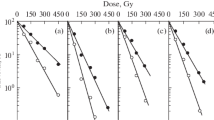Summary
E. coli 15 T - cells were cultured in the presence of cysteine, then removed and subjected to X-ray irradiation in cysteine-free buffer. The radiation-sensitivity was then found to decrease in inverse ratio to the concentration of cysteine used. This phenomenon occurred only with log-phase cells, while the radiosensitivity of stat-phase bacteria remained unchanged.
The biochemical background of this phenomenon was also studied by means of 35S-Cysteine. The extent and distribution of cysteine incorporation into the fractions of log-phase cells were found to differ from those occurring in the fractions of statphase cells.
The biochemical radioprotective effect of cysteine described above suggests two different explanations: a) the radioresistance induced by cysteine presupposes an active metabolic state of the cells, which may correlate with the induction of the repair systems; b) the cysteine incorporated by the cells provides a radio-protective effect; hence only the radiosensitivity of log-phase cells decreases, while that of the stationary phase cells remains unchanged owing to their inability to incorporate cysteine in an amount rendering them effective radioprotectors.
Similar content being viewed by others
References
Bacq, Z. M.: Mechanisms of action. In: Chemical protection against ionizing radiation, pp. 180–239. Springfield: Ch. C. Thomas 1965.
Billen, D., and G. N. Jorgensen: Environmental conditions affecting the expression of X-ray-induced lethality in an auxotrophic bacterium. Radiat Res. 22, 535–542 (1964).
Bhuvaneswaran, C., and A. Sreenivasan: Effect of cysteine on respiration and catalase synthesis by Saccharomyces cerevisiae. Biochem. J. 92, 504–508 (1964).
Eaton, M. D., and A. R. Scala: Toxic action of cysteine on ascites tumor cells in vitro. Exp. Cell Res. 33, 481–494 (1964).
Lowry, O. H., N. J. Rosebrough, A. L. Farr, and R. J. Randall: Protein measurement with the folin phenol reagent. J. biol. Chem. 193, 265–275 (1951).
McIlwain, H.: Thiols and the control of carbohydrate metabolism in cerebral tissues. Biochem. J. 71, 281–285 (1959).
Nagy, Zs., F. Hernádi, P. Kovács, and T. Vályi-Nagy: Radiosensitivity of Escherichia coli 15 T - and metabolic effect of cysteine. Radiat. Res. (in press) (1968).
Roberts, R. B., P. H. Abelson, D. B. Cowie, E. T. Bolton, and R. J. Britten: Sulfur metabolism. In: Studies of biosynthesis in Escherichia coli, pp. 319–405. Washington, D.C.: Carnegie Institution of Washington 1957.
Author information
Authors and Affiliations
Rights and permissions
About this article
Cite this article
Nagy, Z., Hernádi, F., Kovács, P. et al. Correlation between the physiological state of bacteria and the radioprotective effectiveness of cysteine. Archiv. Mikrobiol. 61, 327–334 (1968). https://doi.org/10.1007/BF00409669
Received:
Issue Date:
DOI: https://doi.org/10.1007/BF00409669




